Witch Hunts and True Heroes: Reading Violette Malan’s The Sleeping God
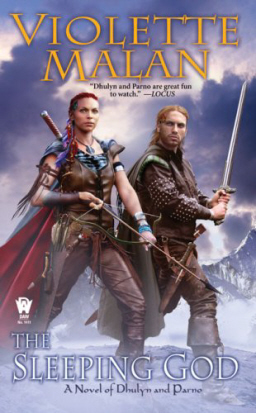 The Odin’s Day Poul Anderson work scheduled for discussion this week is The High Crusade. But, since I find that I have very little to say about it, I’ll focus instead on Violette Malan’s The Sleeping God.
The Odin’s Day Poul Anderson work scheduled for discussion this week is The High Crusade. But, since I find that I have very little to say about it, I’ll focus instead on Violette Malan’s The Sleeping God.
Last week Elizabeth Cady asked Black Gate readers what she should read next. I would never deign to give her an answer. As a reader and a scholar, in general I find that book recommendations more often curse than bless. Here is my simple reasoning for this: There simply is too much to read already. I don’t even want to think about accommodating every well-meaning aunt, mother-in-law (notice the gender bias here? I’ll let it stand: I infrequently receive recommendations from men in the family), neighbor or co-worker who says, “Oh, I see you like to read. Well, you absolutely must read FILL IN THE BLANK.” These recommendations are all the worse (I’m sure many Black Gate readers can testify) when the recommenders are pushing a book on you for no other reason than that they have noticed that you read at all in a culture wherein so many don’t. As such, they often don’t recognize the fine distinctions of what genres or periods in which one might prefer to read.
On many occasions I have thought about and discussed reading through food metaphors. The title of the lengthiest work from food thinker Michael Pollan frames this discussion perfectly. The title is The Omnivore’s Dilemma. In that work, Pollan argues that a modern Homo sapien in what are considered “developed” countries is confronted in the supermarket with a similar complexity of choice that his or her distant ancestor experienced. In a state of nature, the human must choose amongst a variety of foods that grow in the wild. What is nutritious? What will make you sick? What should be sampled in moderation? Now, Pollan argues, the food system has processed these foods into – in some cases – potentially lethal formulations. In the supermarket, Homo sapiens face similar challenges that their ancestors did: What is good for me? What will make me sick? What might cause cancer?
Now, reading the wrong books might not diminish one’s health, but today there certainly is a multiplicity of choice. When it comes to reading, the food metaphor breaks down when one considers that, in reading, there might be an “end” in view. If wisdom and education is the goal, one might consign all one’s reading to the rightly challenged “classics.” In this view recent publications and genre fare might be considered a sweet or an indulgence. Nick Ozment once shared with me, if I remember it rightly, C.S. Lewis’s recommendation that, for every contemporary work one reads, one should read five classics. Gene Wolfe has said that life is too short to read “bad books.” (And somewhere lost in the Black Gate archives, Ozment himself has brilliantly broken down just how much time, in our lifetimes, we have for reading). One interpretation of Wolfe’s suggestion is that reading should be mostly pleasure-based. If this is so, depending on one’s definition of “pleasure,” one might safely ignore many of the offerings on “canonical” lists.
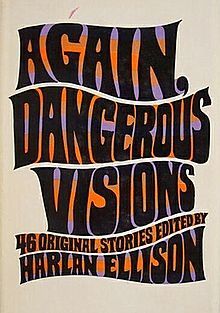 And considerations of “canon” is just one of the ways through which many of us attempt to find structures for our reading. We might adopt Clifton Fadiman’s Lifetime Reading Plan or any number of organizations’ lists of best 100 novels. Academics, of course, choose an author and a period in which to specialize. I myself often have a number of books on deck (a diverse diet is best, to move briefly back to the food analogy). Right now I have a bookmark in a Poul Anderson novel (of course – this being my latest attempt at an academic specialization in a Black Gate context), but also bookmarks in Harlan Ellison’s Again, Dangerous Visions, The Best of C.L. Moore (edited by Lester del Rey), and Steven Erikson’s House of Chains. Since the passing of one of our greatest luminaries, I have added another Terry Pratchett novel to the queue. Asimov’s Science Fiction is the only source of new, short fiction to which I am subscribed and regularly read cover to cover. Since I started contributing to Black Gate, I have found that fantasy and Sword and Sorcery have dominated my deck (is this now a playing-card metaphor?). I have retired, for now, back to the bench the Library of America anthology of Harriet Beecher Stowe and the Everyman selections from Aristotle.
And considerations of “canon” is just one of the ways through which many of us attempt to find structures for our reading. We might adopt Clifton Fadiman’s Lifetime Reading Plan or any number of organizations’ lists of best 100 novels. Academics, of course, choose an author and a period in which to specialize. I myself often have a number of books on deck (a diverse diet is best, to move briefly back to the food analogy). Right now I have a bookmark in a Poul Anderson novel (of course – this being my latest attempt at an academic specialization in a Black Gate context), but also bookmarks in Harlan Ellison’s Again, Dangerous Visions, The Best of C.L. Moore (edited by Lester del Rey), and Steven Erikson’s House of Chains. Since the passing of one of our greatest luminaries, I have added another Terry Pratchett novel to the queue. Asimov’s Science Fiction is the only source of new, short fiction to which I am subscribed and regularly read cover to cover. Since I started contributing to Black Gate, I have found that fantasy and Sword and Sorcery have dominated my deck (is this now a playing-card metaphor?). I have retired, for now, back to the bench the Library of America anthology of Harriet Beecher Stowe and the Everyman selections from Aristotle.
How is it, then, that I found myself reading (and finishing, within a week) Violette Malan’s The Sleeping God?
The answer to that question – and to the question of what one should read during those odd moments when a space has opened up – may very well be “community.”
For many years now, I have had the good fortune to have VIP, front-row seats to the most recent productions of Nick Ozment and Frederic S. Durbin. At core, perhaps reading should be selected from one’s fellow writers and friends, people who share similar values and worldviews. Many book clubs, particularly themed clubs, often accomplish this sense of connection by inviting to their meetings the writers whose works they are reading.
If we are going to read, perhaps we should buy – ideally – directly from the writer. In the event that this is unlikely or impossible, we should hope at least to have a relationship with a bookseller. I am fortunate enough to have two used bookstores in my community, and this is in part how I came to be reading Malan’s The Sleeping God. The other part of how this came to be is, of course, because of the community here at Black Gate.
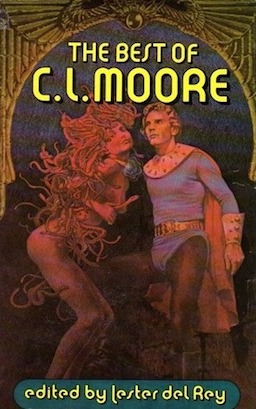 But let me linger on the topic of booksellers for a moment. I don’t know how these courageous souls do it. I once mentioned to one of the bookstore owners in my community, “We’re just scrabbling about in the detritus of yesteryear.” To which he sadly nodded his head. It seems like these people can’t make any money off books. If they are lucky enough to sell a book in the first place, the tradition on the sale of a used book is that you charge a fraction of the original cover price. (Malan probably didn’t get anything from the used copy of her work that I ultimately purchased, though perhaps she may benefit, in one small measure, from the awareness of having one more reader.)
But let me linger on the topic of booksellers for a moment. I don’t know how these courageous souls do it. I once mentioned to one of the bookstore owners in my community, “We’re just scrabbling about in the detritus of yesteryear.” To which he sadly nodded his head. It seems like these people can’t make any money off books. If they are lucky enough to sell a book in the first place, the tradition on the sale of a used book is that you charge a fraction of the original cover price. (Malan probably didn’t get anything from the used copy of her work that I ultimately purchased, though perhaps she may benefit, in one small measure, from the awareness of having one more reader.)
Because of this thrift, in my library I have piles of books, acquired from these two bookstores, that inexpensively were published decades ago. Largely because of the conversations of many on this site, I now have stacks not only of Poul Anderson but of Gordon R. Dickson and Clifford Simak and Roger Zelazny and Michael Moorcock and C.J. Cherryh and Jack Vance and Philip Jose Farmer, not to mention all the delightful, single-volume science fiction oddities that seemed totally worth the mere quarters and dimes that were being asked. What I’m saying is that, for a few greenbacks, from these places one can acquire reading material to last a couple of years, at least.
And it was coming into one of these stores, to scrabble about in the usual detritus, that I saw a name I recognized: Violette Malan. Wait, why do I recognize that name? I asked myself.
There were three matching volumes, all different Dhulyn and Parno novels, and they were not books I normally would have bought. We’ve all been told not to judge a book by its cover. But don’t we do so anyway? Aren’t covers designed with certain audiences and demographics in mind? Knowing this to be so, I asked myself if I truly was the chosen demographic for a Dhulyn and Parno novel?
With what I’m about to observe, I certainly intend no disrespect to the cover artist Steve Stone. I merely want to analyze, from a sales perspective, how I react to his cover for the Dhulyn and Parno novel The Sleeping God. His cover image showcases two characters with their weapons out. They are “battle-ready,” even though nothing apparently is going on. It almost feels like they’re posing for senior photos – you know, the photos for which people take up some of the stuff they’re interested in, pirouetting with tennis rackets or hockey sticks or musical instruments. And to speak of photos – the photo-realistic expressions on this cover are not good selling points for me. Print is one of the few media that is free of the domination of the image, but this cover appeared to revel in it, to hope to indelibly fix the faces of the characters in the minds of the readers before they even cracked the covers. How could it be that, as I read this book, I would be able to imagine these characters any other way?
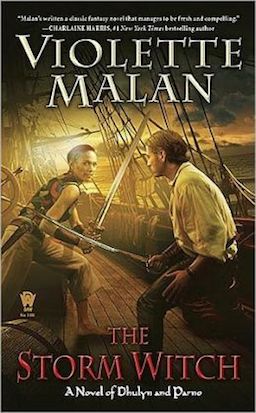 That said, when I did get around to reading the book and encountered the first description of Dhulyn, with every other word I flipped from the text to the cover, and Stone’s cover certainly is a faithful description – or commission – of the character (perhaps with the exception of her skin tone and her “wolf smile,” neither which seemed to come out properly on the cover).
That said, when I did get around to reading the book and encountered the first description of Dhulyn, with every other word I flipped from the text to the cover, and Stone’s cover certainly is a faithful description – or commission – of the character (perhaps with the exception of her skin tone and her “wolf smile,” neither which seemed to come out properly on the cover).
But to move back into that bookstore, by now I had a fairly good idea that I recognized the name of this writer because of her contributions to Black Gate. But even then I did not buy the book – priced at $7.50, half off the original $15.00. Why did I need to spend more money on books? I asked myself. Did I even have time to read it, with all my other stacks at home?
But the next day I went back and bought that first volume. I would give it a try. Didn’t I owe it to that recognizable name? I have heard that, more and more, these days authors need to work full time – even when they are published by established houses – to promote themselves and their works. If authors are brands, and if what I have heard about brand recognition is true – that a consumer has to hear the name of a brand at least seven times before he or she will try the product – then Malan had achieved this with this audience of me. Moreover, since she is a member of the Black Gate community, I was all the more willing to wantonly spend that $7.50. After all, in the interest of community, what really is a “loss” of $7.50?
I hadn’t read more than a couple paragraphs of The Sleeping God before I went back and bought the other two volumes (even though the covers still didn’t appeal to me).
What was it about those initial chapters that had me read on and buy more, even though I honestly didn’t predict any time for it in the future? I think it has something to do with Malan’s set up. There is a fire. Townspeople have decided to burn down the home – with children in it – of a member of the Marked. Wait, there’s nothing so original or arresting about this, right? We see witch-huntings and burnings in fantasy literature all the time. But the crowd behaved strangely. One of our heroes – and heroes these two truly are, catching wind that something is amiss and, disregarding their own safety, immediately riding to aid – notices a strange man with glowing green eyes.
It’s the universal law of storytelling. Malan had captured me. I simply wanted to know what happened next.
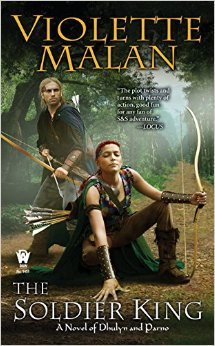 Another thing that grabbed me was Malan’s deft descriptions of characters. I already have said that these two are true heroes. I liked their manners. But I also liked their interests. Dhulyn is nicknamed the Scholar because, despite her savage background, she has a healthy interest in books and scholarly questions. I also appreciated how real Malan’s details felt. The book opens with a journey, which kind of indicated that this was going to be a traditional quest fantasy and not the urban fantasy that it quickly becomes when the characters reach the city of Gotterang. The details about camping and travel by horse – and especially the details about martial training and fighting – had me immersed.
Another thing that grabbed me was Malan’s deft descriptions of characters. I already have said that these two are true heroes. I liked their manners. But I also liked their interests. Dhulyn is nicknamed the Scholar because, despite her savage background, she has a healthy interest in books and scholarly questions. I also appreciated how real Malan’s details felt. The book opens with a journey, which kind of indicated that this was going to be a traditional quest fantasy and not the urban fantasy that it quickly becomes when the characters reach the city of Gotterang. The details about camping and travel by horse – and especially the details about martial training and fighting – had me immersed.
As I completed this volume, I realized that much of what I liked about this book was reminiscent of another favorite writer of mine, one who also is published by DAW. Her name is Sherwood Smith. Smith, too, I read because of community. When Nick and I started our own magazine, we solicited material from Smith because her “Mom and Dad at the Home Front” (which I first read in Realms of Fantasy magazine) so perfectly represented the kinds of fiction that Nick and I wanted to showcase.
That started a friendship that resulted in me voraciously reading all I could get from what she at one time has referred to as her “Long Project.” Many of the novels in her Long Project have been published by DAW (beginning with Inda in 2007). Like those works, Malan’s The Sleeping God is much more than what the cover would suggest; Malan’s POV lens is not only centered on Dhulyn and Parno but regularly glides into the psyches of many other interesting and likeable characters.
Come to think of it, Patrick Rothfuss also is published by DAW, and my reading of his book began as a community connection, as well. With Nick, I met Pat at a World Fantasy Convention, when he was not yet Known, and my first edition of The Name of the Wind, bought in person from Pat at that convention and affixed with his penned guarantee that reading that book will help me “get chics,” is my proof.
With The Sleeping God, Malan has done what any writer aspires to do. She has created a whole host of interesting characters, all with their own interesting motivations and objectives, and has worked out the attempts of those characters to attain those objectives to a satisfying conclusion. I am glad that Malan is in the Black Gate community and that one of my neighborhood bookstores happened to have three of her works. I will read a Dhulyn and Parno novel again. The question is — when there is so much to read — when.
Can’t thank you enough for this wonderful post, Gabe. It’s always affirming when someone gets exactly what it was you were trying to do.
[…] a month ago Gabe Dying wrote an excellent post in which he, among other things, praised my Dhulyn and Parno Novels (thanks again, Gabe). I […]